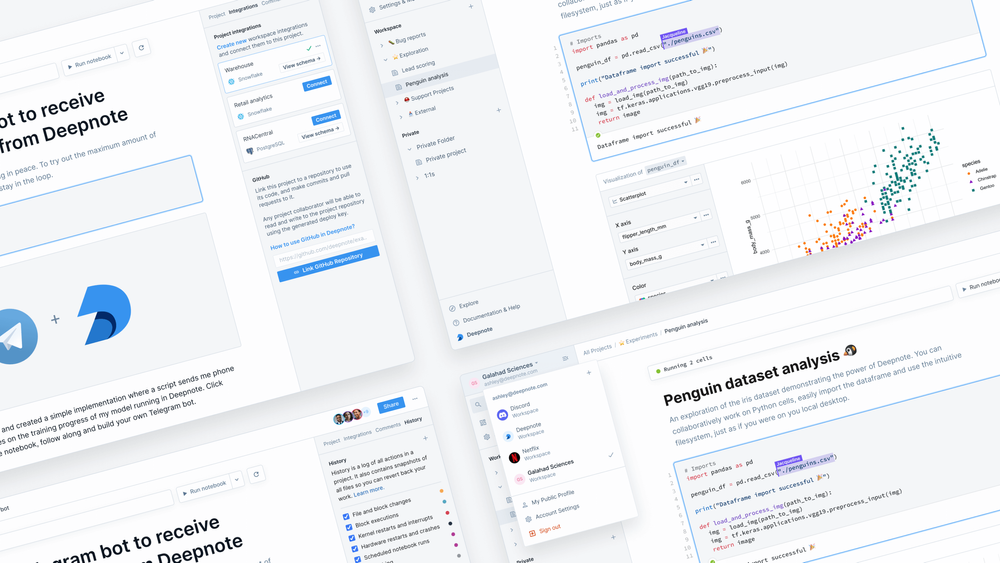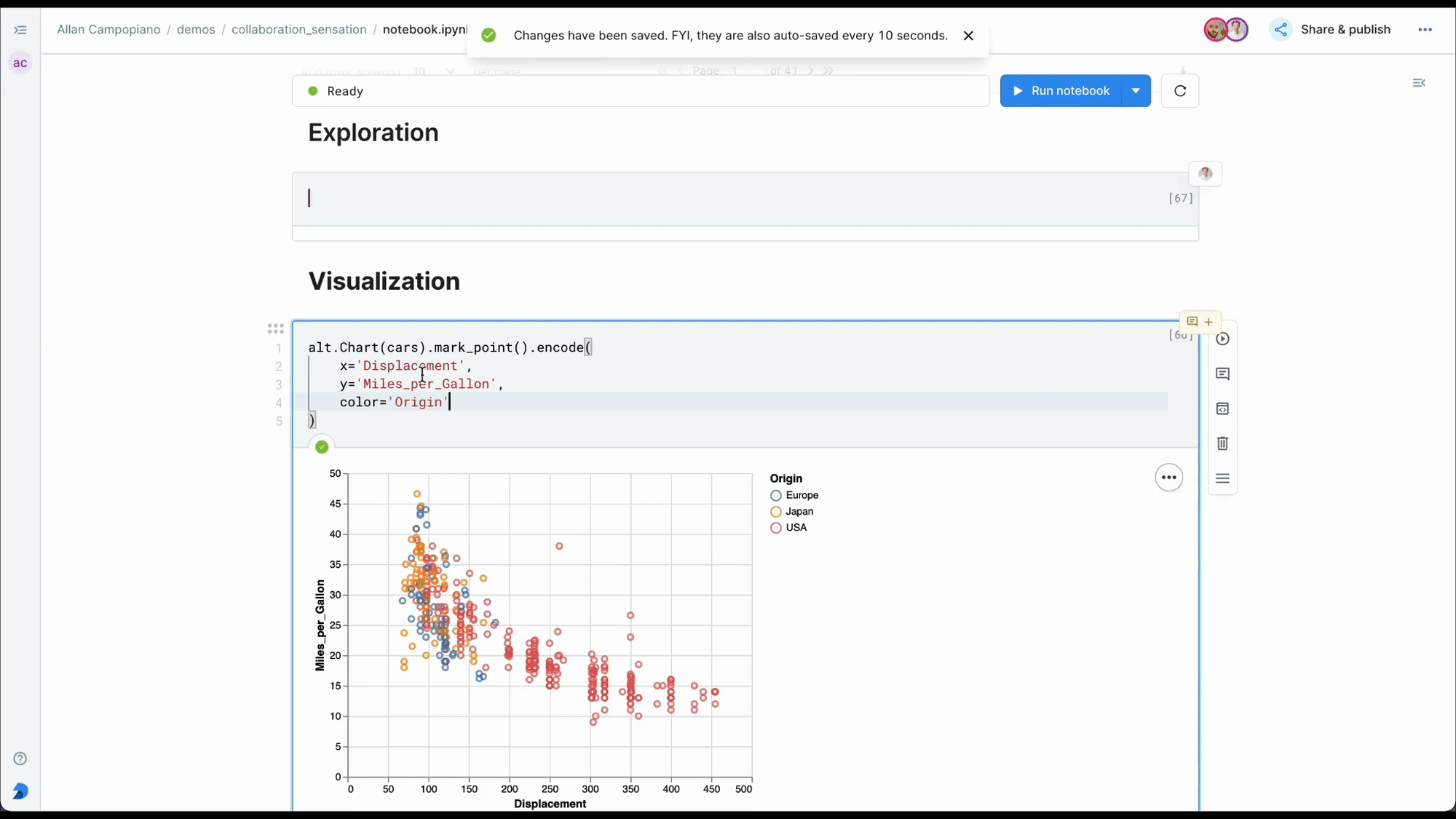The first beta version of Deepnote launched in October 2020 on a simple premise: Build a better data notebook.
We took notice of the leaps in productivity and collaboration changing the way software was built and wanted to bring both to the much younger data notebook market. We saw how fast-growing companies such as Figma unlocked design beyond design teams, and we knew notebooks could serve as a medium to expand data accessibility and literacy beyond data teams.
At the time, notebooks had many pain points — version control, reproducibility, and collaboration, to name a few. They also didn't easily integrate with the modern data stack. And they didn't encourage engineering best practices.
Ever since launching in beta, we've seen widespread market adoption, with thousands of data teams now using Deepnote. We’ve more than doubled our team size in the last year and we’ve been backed by the world’s best investors, who believe in our vision of notebooks.
In short, we’re ready to remove the “beta” label and become generally available for the world’s best data teams.

How we built a better data science notebook
To address the limitations of notebooks, we built Deepnote with three core principles in mind:
1. Collaboration
Data science and analytics are collaborative by nature, so we made collaboration a first-class citizen in Deepnote. We envisioned a collaborative space where sharing the work of data teams is as simple as sending a link, analysis is done in real-time with others, and everything is organized.
2. Connectivity
Notebooks should play nicely with the modern data stack because meaningful insights don’t come from fussing with integrations. Since we launched Deepnote, we've added dozens of integrations with modern data tooling and will continue making Deepnote a perfect environment to interact with the rest of your data stack.
3. Productivity
We launched Deepnote with the ability to write clean code, define dependencies, and create reproducible notebooks. We also built a really good autocomplete system and added a variable explorer.
Helping data teams solve the hardest problems
At Deepnote, we see notebooks as a new kind of computational interface. The type of interface that helps data teams solve new types of problems, including those with both technical and organizational complexity.
Deepnote is an environment that combines powerful compute, fast feedback loops, and hassle-free collaboration.
We built Deepnote so that data teams can focus on problems, not tooling.
Making data science & analysis collaborative
To make data science and analytics more accessible, we've built collaboration at the core of every feature we ship. We've shipped a ton to help with collaboration in the past year. Here are a few highlights:
Workspaces
Proper organization of insights is critical to make the learnings accessible. Meaningful data insights often start with an individual, then get reviewed and polished by peers, and finally delivered to stakeholders for action. We built workspaces with the flexibility to work in any way your team does. You can explore on your own, collaborate together with your data team, or share notebooks across your whole organization. Workspaces allow data teams to create hundreds or even thousands of notebooks without losing track of the most important learnings.

Real-time collaboration
Invite a team member to your project and work together in the same execution environment, at the same time. The best analytics environments minimize feedback loops. Reviewing code, commenting on visualizations, or debugging issues all happen in real time.
Publishing
We made sharing data notebooks as easy as sending a link (think Google Docs for data work). With Deepnote, you have full control over which blocks of your notebook are visible and who has visibility — public, anyone with a link, only your team. No more sending screenshots over email or Slack to share a finding or get feedback on your work.
“Our team was used to Google Docs, so when we moved over to Deepnote, we appreciated the similar look and feel as well as the added scalability — we’re no longer copying and pasting screenshots from external sources.”
Scott Jacobsen, Head of People Analytics & Insights, Gusto
Playing nice with the modern data stack
Part of offering a comprehensive platform for data teams is making it easy to plug into your data stack and the languages/frameworks data practitioners are familiar with. We want Deepnote to be the place where you focus on meaningful data work regardless of the specific tools you're using.
Data warehouses
Wherever your data is stored — from your cloud data warehouse to a local CSV — you can easily access it in Deepnote. Connect to Postgres, Snowflake, S3, BigQuery, and dozens of native data integrations.
From Python to SQL and back
Deepnote allows you to work with the right language for the job. You can easily switch between Python and SQL or drop down to Julia or R for more specific tasks. SQL results are instantly saved as Python DataFrames, so you can query your database in SQL and then use Python to export your data as a CSV or create complex machine learning models. You can also create programmatic SQL queries by embedding Python variables and DataFrames in your SQL queries.
Bringing software engineering innovation to data teams
We've incorporated the best practices from software engineering — clean code, defining dependencies, reproducible notebooks — to empower underserved data teams. Analysts and data scientists should have the tooling to be just as productive as software engineers. We're adding productivity features to Deepnote practically every day to make that a reality. Here are a few highlights from the last year:
Code intuition
When you write code in Deepnote, we help you focus on the problem at hand with features such as autocomplete, surfacing function definitions, and go-to definitions.
Reactivity
Deepnote solves a core problem with traditional computational notebooks: reactivity. We've designed Deepnote to be fully reactive. Whenever code is changed or a cell is deleted or moved, outputs are automatically updated as if the notebook was executed fresh, from top to bottom.
Scheduling
We added the ability to run notebooks while you're away with scheduling. Execute your notebooks hourly, daily, or weekly to process data or update a dashboard at a regular frequency.
“Using Deepnote helps our team bring people into the phase of data science that’s usually unseen — the exploratory data analysis phase — and drive an understanding of the effort and work that goes into the data science process. Most other tools are made for the final version of a product — they skip past intermediate steps where feedback and buy-in are critical. To be able to bring people along with the data work, especially remotely, is hugely valuable.”
Allie Russell, Senior Manager of Data Science & Analytics, Webflow
Building for scale & security
Because Deepnote is a collaborative product that connects to the data stack, we built it to be both performant and secure. As adoption spreads from a single analyst to an entire organization, data teams have the flexibility to customize machines to maximize performance, and security teams have full control over user permissions and access.
Customizable environments
By default, every project in Deepnote runs on a fully managed cloud-hosted environment, so data teams don't need to worry about initial setup. Everything is secure by default and works out of the box. For use cases requiring more computing or specialization, changing a machine is as simple as clicking a button and selecting an option for more memory or GPU.
User permissions
Deepnote admins have full control over who can access and contribute to a workspace, from view only business users to data scientists producing notebooks.
SOC2
Deepnote has SOC 2 Type II certification, which shows that our software development processes, technical security controls, and administrative procedures meet the required levels of oversight and monitoring defined by the industry standard.
Our vision for the future
While we're proud of what we've built, there's still a long road to reaching our mission. Removing the "beta" label is just a small step to making data science more collaborative and accessible.
We'll be accelerating product velocity, doubling the team, and investing even more in supporting our customers and community in the coming year. We envision a notebook that helps everyone work with data — a place where teams can collaborate without barriers and where problems get solved.
Join the world’s best data teams and start using Deepnote today.